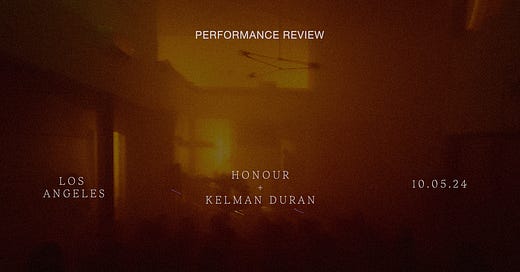South of Los Angeles’ 10 interstate highway, Deluge, the experimental ambient series, returned architect Rudolph Schindler’s Bethlehem Baptist Church--operating today as a funeral home--to its original form: a site for worship. Billed by series organizer Kelman Duran and the London based musician Honour, together they besieged the former chancel with mixers, amps, keyboards, and microphones, elegantly bookmarked by two funeral-style heart shaped reeves, fine tuning the historic building for their music. Walking in the diamond shaped-room one is immediately confronted by the stage with church benches arranged in a v-shape mimicking the feel of congregation, minimizing anonymity.
Duran set the tone for the night, playing a slow electronica as a base to embellish with archival digs: veering in and out of political speeches and rare rap deep-cuts. I arrived towards the last quarter of his set. Parking in Vernon is close to non-existent; in response, its Latinx residents double-park in pursuit of birthday bouncy houses and cookouts in front yards. A huge let down because anyone familiar with Duran’s musical practice knows his sets (ambient or club) are exhibitions of his recent internet archive deep dives. Duran is a researcher, inclined to trace the absences in music archives, zeroing in on forgotten and unsung heroes, sampling them in new songs aiming for them to be remembered or for the issues to be well pronounced and understood; see his tribute to Memphis rapper Princess Loko on Beyonce’s Renaissance opener “I’m That Girl,” “These (please), motherfuckers ain’t stopping me.”
Half-history and half-philosophy lecture, his live sets collage together deep-cuts, field recordings, and political speeches, where he often cranks up a vocal to a high looney-tune pitch to recontextualize it or let it play raw--unaltered-- over a minimalist score allowing the listener to sink into its meaning. Duran’s navigation of space and atmosphere to reinterpret or create meaning distinguishes him as an artist interested in how histories are circulated, expressed, guided by how they could be given more life, in contrast to overdetermined sets with an aggressive ambition of proving a thesis statement, which often abstracts a musician’s original intent. Those familiar with Duran’s 2016 Rail Up days know his early dancefloor sketches that layer political speeches over his signature electronic-dembow. Fast forward to 2024, Duran has honed his personal signatures and sense of timing; how and when things should be blended or when things should be given room to breathe. What I was able to catch in that last quarter was Duran winding things down, stripping audio layers back to arrive at a clearer head-space, letting his personal finds, historically significant or not, shine on their own terms.
The night’s open-ended tone took a turn for the commissioned performance by Honour, “Julianna (is this Yours?),” where the London based musician spent his hour–long set meditating on the hues of death. He arrives on stage masked and hooded like the grim reaper, dispelling his introductory music, adjusting the mood to properly begin. He deploys the first dispatch: “Heartaches,” by Charles Watkins and The Pentecostal Mass Choir (1964,) a poignant song on God’s loving grace, capable of healing the most bruised of hearts. Like an altar assistant, Honour tinkers and adjusts his music machines, surrendering the stage to Watkins’ beautiful baritone enveloping the room, “There's a song in my soul, that the world cannot hear/There is music no mortal can play/He has banished my fears.” It’s such a devastating song about the alienation of one’s despair and the gratitude for one’s God, although when played in the first quarter of the performance, it served as a centerpiece from which Honour expanded and complicated the somber gospel song’s original intent. He welded the song as a question for the individual and collective individual demons that seduce oneself or a nation to reach for the gun.
Where the music stood on its own, the reliance on the theatrics of lasers, lighting, and fog, at times, worked against the earned intimacy the artist built with the audience. It was as if the former church rejected the secular club equipment intended for the vastness of a warehouse or stadium. Moments of contemplation and awe would be dashed by a laser beam. At their best the room engulfed in reds and whites enhanced the music’s transcendental aims. What sustained the performance was Honour’s conduction of tension, suspension or withholding and space, with the music and his body, momentarily sitting down on stage or the initial refusal of denying the audience the sight of his face. His relaxed dexterousness with himself and his music allowed him to make interesting juxtapositions.
He continued with a woman’s voice crying and begging God to guide misguided souls back to him, ”And yet if they want to end their lives, father, let them know they are not alone…Father have mercy, we speak to the spirit of suicide and we send it back to the pitts of hell where it comes from…” reminiscent to Honour’s execution of the Watkin’s song where the weight of the words required minimal musical support to let the message sink in the audience. He then heightened the sentiment even more by blending in a new clip recounting the beloved Louisiana rapper Lil Wayne retelling his suicide attempt at the age of 12 on the Uncomfortable Conversations podcast, personifying the ghoul of suicide into the charming rap champion. Retelling his suicide scene Lil Wayne remembers a young Dwayne Michael Carter Jr. looking in the mirror with the gun in his hand and mind racing frustrated that he had been caught ditching school and lying to his mom, coincidently watching Biggie Small’s “One More Chance” music video through a mirror before the bullet entered his chest. Ominous coincidences like these transcend the definition of fate for something more extreme, like what the artist and DJ Crystallmess has theorized as a hyperfate, describing the prophetic intimacy rappers share with death, which often functions as a sadistic right-of-passage plaguing rappers and hip-hop culture at-large. When asked what it was that kept him alive that day Wayne replied, “God. Plain and simple.” Juxtapositions like these so well-researched and thought-through shined in Honour’s performance, where the exhibitionist aspects of death and suicide were dismissed for a deeper study on the pervasive nature of death in black music, inflicting ruin and inhabiting those ruins.
With the cerebral force the performance invoked, even if it required spending time with the performance’s footnotes, it proved a difficult challenge to neatly land and conclude. How do you end a performance about spiritual warfare and death? The artist exited the stage leaving the audience with an electronic chug of a glitched gospel hymn. He reappears on the church’s visible second floor right above the stage, microphone in hand, masked and with a bandana draped over his head, chanting along as the music picks up speed. A default gesture reminiscent to the grandeur of arena tours of Ye’s Donda or his junior Travis Scott's AstroWorld (which was its own hyperfated and deeply problematic death note) but in the tininess of the former church it fell flat. However, the artist did have the correct impulse. One must first exit the stage.






